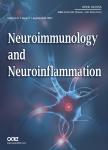Bee venom acupuncture reduces neuroinflammation modulating microglia/macrophage phenotype polarization in spinal cord injury compression model
作者机构:Department of Physiological SciencesInstitute of Biology and Health SciencesFederal Rural University of Rio de JaneiroSeropedica 23897-000RJBrazil Carlos Chagas Filho Institute of BiophysicsFederal University of Rio de JaneiroRio de Janeiro 21941-902RJBrazil.
出 版 物:《Neuroimmunology and Neuroinflammation》 (神经免疫与神经炎症(英文版))
年 卷 期:2019年第6卷第11期
页 面:1-13页
学科分类:1006[医学-中西医结合] 1005[医学-中医学] 100502[医学-中医临床基础] 10[医学] 100602[医学-中西医结合临床]
主 题:Acupuncture bee venom spinal cord injury compression microglia macrophage neuroinflammation
摘 要:Aim: The present study aimed to examine whether apipuncture (stimulation of acupuncture points with bee venom)at ST36 and GV3 acupoints promotes neuroprotection and reduces neuroinflammation by modulating M1 and M2 phenotype ***: Wistar rats were treated with bee venom (BV) (0.08 mg/kg) injection at acupoints ST36 and GV3 [BV (ST36 + GV3)-spinal cord injury (SCI)] or BV injection at non-acupoints [BV (NP)-SCI] or no treatment (CTL-SCI)after SCI by compression. The spinal cord mRNA expression of iNOS, Arg-1 and TGF-β was measured by real time PCR and the levels of IBA-1;BCL-2;NeuN e CNPase was measured by western blotting. Locomotor performance was measured by Basso, Beattie, and Bresnahan (BBB) and grid-walking ***: Apipuncture treatment was able to (1) ameliorate locomotor performance;(2) reduce inflammatory markers (Cox-2 levels) and activation of microglia and macrophages;(3) reduce the polarization of the M1 phenotype marker (iNOS) and increase M2 (Arg-1 and TGF-β) phenotypic markers;(4) promote neuroprotection by reducing the death of neurons and oligodendrocytes;and (5) increase the expression of the anti-apoptotic factor ***: Apipuncture treatment induces locomotor recovery and neuroprotection after the compression model of spinal cord injury. Further, it reduces neuroinflammation by decreasing M1 polarization and increasing M2 phenotype.



